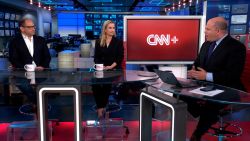Disney+ will launch November 12, a fact that’s hard to miss if you watch any of the TV networks that the studio owns. That raises a question that won’t be sorted out for some time: Are media companies hastening the decline of their existing networks as they pivot to a streaming future?
Think of it as a new variation of robbing Peter to pay Paul – except here, it’s taking from Mickey and Donald to advance Buzz Lightyear, their new space-age pal.
The expansion of streaming – both by studios and tech players, including Apple TV+, which makes its debut November 1 – comes as the economics of broadcasting are under stress. Cord-cutting also threatens the future of middle-tier and smaller cable networks, which rely on subscriber fees from the cable/satellite bundle in order to survive.
So will streaming simply add to the cornucopia of available content – and potential fatigue among consumers, inundated with options and trying to sort out what’s where – or will it merely cannibalize traditional channels?
Whatever the outcome, the shift to streaming represents “a pretty serious rejiggering of the business model,” Ted Harbert, the former chairman of NBC Broadcasting, told CNN Business.
We’ve been here before
The current scenario leaves new players seeking a breakthrough like “House of Cards” – which helped put Netflix on the map – while absorbing the expense of stocking the shelves of new SVOD (subscription video on demand) services with programming.
“That subscriber fee has to be spread across a bunch of content,” Harbert said. “In the meantime, these things could be a real drain on the bottom line as you wait, and pray, for people to sign up.”
If the digital conundrum facing TV sounds familiar, it should. To a degree, it mirrors the transformation of newspapers from print into digital-first operations, amid warnings that the industry was exchanging hard-copy dollars for what amounted to digital dimes.
There’s obviously a lot more money than that in streaming, which explains why media and tech players are crowding into that space. Disney (DIS) and Apple (APLE)add deep-pocketed competitors to Netflix (NFLX), Amazon (AMZN) and Disney (DIS)-controlled Hulu, while entities like CBS All Access have sought to carve out their own turf.

Undermining established networks is just one of the thorny issues that the streaming wars have fostered. With AT&T (T) unit WarnerMedia’s HBO Max and Comcast (CCZ)’s the Peacock both gearing up for 2020, these companies appear determined to test the limits of consumers’ willingness to pay directly for content.
During its presentation earlier this week, WarnerMedia officials acknowledged that part of the task associated with launching the new service would be managing the decline of existing channels, while projecting profitability for HBO Max in 2025.
Studios are also sacrificing short-term revenue not only by investing heavily in streaming shows but moving properties like “Friends” and “The Office” from platforms that were paying big money for them, like Netflix, to these fledgling entities.
Disney competes with Disney+
While some of the tradeoffs are obvious, others appear more subtle. Just using Disney+ as a case study, they underscore the leap into the unknown baked into what CEO Bob Iger has identified as the company’s top priority.
The number of high-profile series being used to launch the streaming service would have surely found homes on existing Disney channels.
Nor is it just the networks that are potentially paying a price, but the studio’s movie division as well. In a pre-Disney+ world, a “Star Wars” prequel in which Ewan McGregor reprises his role as Obi-Wan Kenobi would be a theatrical blockbuster. Instead, Disney is positioning it as a premium limited series for Disney+. A live-action version of “Lady and the Tramp” will also premiere on the service.
Broadcast and cable ratings have been steadily declining, undercut by waves of competition. Those networks are nevertheless being asked, in essence, to provide fuel to new services that promise to siphon more time, attention and resources away from them.
Well-versed in the ways of synergy, Disney is using its networks as tools to help drum up interest in Disney+, including a multifaceted marketing blitz that the New York Times described as a “shock and awe” campaign. “High School Musical: The Musical: The Series,” for example, will be previewed on ABC, the Disney Channel and Freeform days before its streaming debut, in much the way CBS used its flagship network to boost the launch of “Star Trek: Discovery” on CBS All Access.
For now, that relationship looks like a one-way street. It’s to be determined where that will lead for traditional networks, and where streaming services will be on the road to profitability by the time those channels reach what could be a dead end.





















